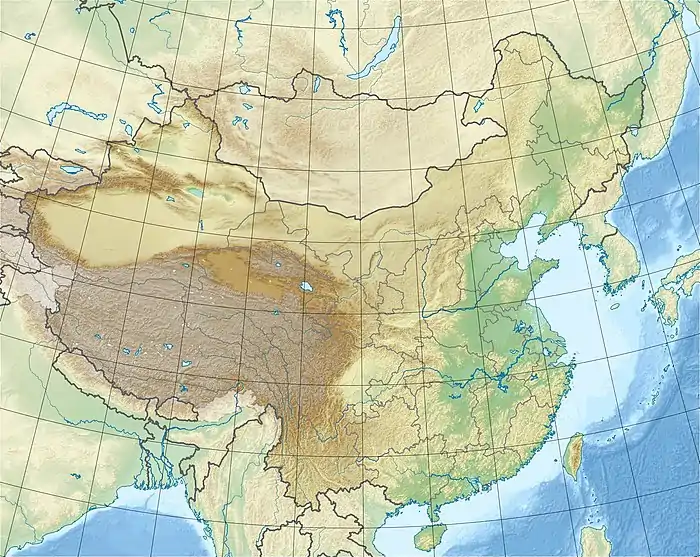吳城 | |
 Location in China | |
| Location | China |
|---|---|
| Region | Jiangxi |
| Coordinates | 27°59′02″N 115°15′36″E / 27.984°N 115.26°E |
| History | |
| Periods | Early Bronze Age |
The Wucheng culture (吳城文化) was a Bronze Age archaeological culture in Jiangxi, China. The initial site, spread out over 4 km2 (1.5 sq mi), was discovered at Wucheng Township, Jiangxi. Located on the Gan River, the site was first excavated in 1973. The Wucheng culture probably developed in response to cultural contacts with the expanding Erligang culture, melding Erligang influences with local traditions. The Wucheng culture was a distinct contemporary of Sanxingdui and Yinxu (Anyang).
The site at Wucheng was a regional protoporcelain production center; the culture is known for its distinctive geometric pottery. The Wucheng culture is also known for its bronze bells, the clapperless nao. The Wucheng site at Xingan contained a rich cache of localized bronze vessels. The bronze axes were similar to those of the Dong Dau culture in the Red River valley.[1]
The earliest period, around 1600 BCE, contemporaneous with late Erligang, yielded pottery shards with inscribed symbols. These are unusual among pre-Anyang inscriptions in China in containing sequences of graphs; shards were found with horizontal sequences of 12, 7, 5 and 4 graphs, suggesting that they may be a form of writing, but quite different in form from oracle bone characters. However, the corpus, comprising a total of 39 graphs, is too small for decipherment.[2][3][4]
Some of these symbols are similar to Shang writing. Around 120 inscriptions have been found altogether.[5]
The site at Wucheng may have played a role in the decline of Panlongcheng. Both sites appeared to have served as regional, competing centers for transporting resources from the south to the North China Plain. Towards the end of the Erligang culture, Wucheng began to grow significantly, while Panlongcheng declined sharply.
Y-chromosome DNA from Wucheng culture sites shows a very different profile from Liangzhu culture sites in the lower Yangtze, suggesting that their populations may have been derived from separate migrations.[6]
References
- ↑ Lapteff, S.V. "The origin and development of the Wucheng culture (in the context of intercultural contacts between Bronze Age inhabitants of the lower Vangtze valley and the Indochina peninsula". Archaeology, Ethnology and Anthropology of Eurasia. 38 (4): 93–102. doi:10.1016/j.aeae.2011.02.008.
- ↑ Wilkinson, Endymion (2000). Chinese history: a manual (2nd ed.). Harvard Univ Asia Center. p. 382. ISBN 978-0-674-00249-4.
- ↑ Wagner, Donald B. (1993). Iron and Steel in Ancient China. BRILL. p. 20. ISBN 978-90-04-09632-5.
- ↑ Cheung, Kwong-yue (1983). "Recent archaeological evidence relating to the origin of Chinese characters". In Keightley, David N.; Barnard, Noel (eds.). The Origins of Chinese Civilization. trans. Noel Barnard. University of California Press. pp. 323–391. ISBN 978-0-520-04229-2.
- ↑ Li Liu, Xingcan Chen, The Archaeology of China: From the Late Paleolithic to the Early Bronze Age. Cambridge World Archaeology, 2012 ISBN 0521643104 p368
- ↑ Li, Hui; Huang, Ying; F Mustavich, Laura; Zhang, Fan; Tan, Jing-Ze; Wang, Ling-E; Qian, Ji; Gao, Meng-He; Jin, Li (November 2007). "Y chromosomes of prehistoric people along the Yangtze River". Human Genetics. 122 (3–4): 383–388. doi:10.1007/s00439-007-0407-2. PMID 17657509. S2CID 2533393.
- Bagley, Robert (1999). "Shang archaeology". In Loewe, Michael; Shaughnessy, Edward L. (eds.). The Cambridge History of Ancient China. Cambridge: Cambridge University Press. pp. 124–231. ISBN 978-0-521-47030-8.
- Chang, Kwang-chih (1986). The Archaeology of Ancient China. Yale University Press. ISBN 978-0-300-03784-5.
- Liu, Li; Chen, Xingcan (2003). State Formation in Early China. Duckworth. ISBN 978-0-7156-3224-6.